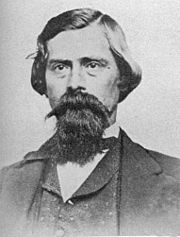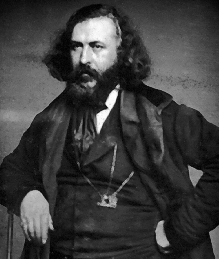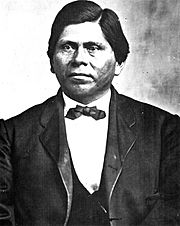Treaty with Choctaws and Chickasaws facts for kids
The Treaty with Choctaws and Chickasaws was an important agreement signed on July 12, 1861. It was made between the Choctaw and Chickasaw Nations and the Confederate States. This happened at the start of the American Civil War.
Albert Pike was a Confederate representative. He worked to make treaties with Native American tribes. One key treaty was with Cherokee chief John Ross. The Choctaw and Chickasaw Nations also agreed to this treaty. Both sides approved it by December 1861.
Some Choctaw people supported the Confederacy. A few even owned enslaved people. They also remembered being forced from their lands 30 years earlier. They felt the U.S. government had treated them poorly. The main reason the Choctaw Nation signed the treaty was for protection. They wanted safety from other tribes in their region.
But, [Colonel Emory], as soon as the Confederate troops had entered our country, at once abandoned us and the fort; ... By this act the United States abandoned the Choctaws and Chickasaws.
—Julius Folsom, September 5, 1891, letter to H. B. Cushman
What the Treaty Said
The treaty started by saying the Confederate States would protect these tribes. They would treat them as their "wards." This meant the Confederacy would look after them. The Choctaw and Chickasaw Nations agreed to this protection.
The treaty had many parts, 64 in total. Here are some of the main points:
- Peace and Friendship: Both sides promised to have lasting peace and friendship.
- Protection: The Confederacy would protect the Choctaw and Chickasaw Nations. They promised not to abandon them.
- Land Guarantees: The Confederacy guaranteed the Choctaw and Chickasaw lands forever. These lands could never be sold.
- Self-Government: The Choctaw and Chickasaw Nations kept their right to govern themselves. Confederate laws would not apply to their governments.
- Intruders: If people tried to settle on their lands without permission, the Nations or the Confederacy could remove them.
- Confederate Presence: The Confederacy could set aside land for agencies and build forts. They could also build railroads and telegraph lines.
- Trade: Traders needed approval from the National Council. Trading could be taxed.
- Citizenship Rights: Choctaw and Chickasaw people could own land in Confederate States.
- Representation: The Choctaw and Chickasaw Nations could have one representative in the Confederate House of Representatives.
- Statehood: Their country could become a state if they chose to. Then, their people would become citizens of the Confederate States.
- Protecting Lands: Confederate citizens could not settle or graze animals on Choctaw or Chickasaw lands.
- Legal System: A special Confederate court, called Tush-ca-hom-ma, would handle legal issues related to the treaty.

Who Signed It
A total of 36 people signed this important treaty.
- Confederate States Commissioner: Albert Pike
- Choctaw Nation Commissioners: R.M. Jones, Sampson Folsom, Forbis Leflore, Geo. W. Harkins, jr., Allen Wright, Alfred Wade, Coleman Cole, James Riley, Rufus Folsom, William B. Pitchlynn, McKee King, William King, John P. Turnbull, William Bryant.
- Chickasaw Nation Commissioners: Edmund Pickens, Holmes Colbert, James Gamble, Joel Kemp, William Kemp, Winchester Colbert, Henry C. Colbert, James N. McLish, Martin W. Allen, John M. Johnson, Samuel Colbert, A. Alexander, Wilson Frazier, C. Columbus, Ashalatobbe, John E. Anderson.
What Happened Next
After the Civil War ended around 1865, things changed for the Choctaw Nation. The Confederacy lost the war, which also affected the Choctaw Nation.
The Choctaw Nation, located in what is now Oklahoma, had allowed slavery until 1866. After the Civil War, a new treaty with the United States required them to free the enslaved people in their nation. These former enslaved people became known as the Choctaw Freedmen. After much discussion, the Choctaw Freedmen were granted citizenship in the Choctaw Nation in 1885.
The U.S. government also gained land in the western part of the territory. They also got rights to build railroads across the Indian Territory.



